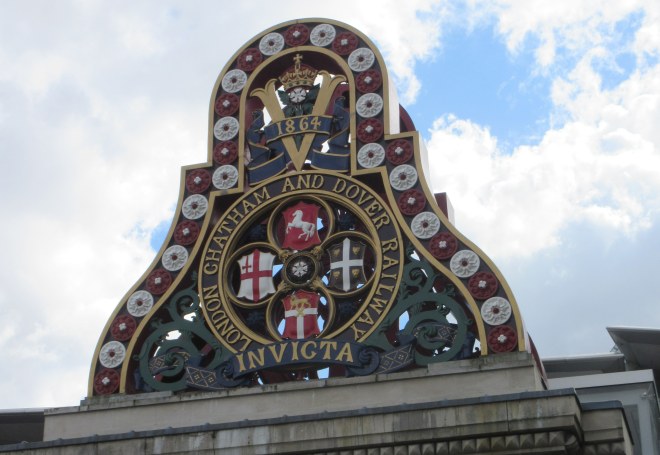We tried to do justice to the breakfast to get our money’s worth, then headed back to the DLR to the western end of that line. Bank station
As you come out of Bank station you really can’t miss the Monument which stands at the junction of Monument and Fish Street Hill in the City of London.

The Monument was built between 1671 and 1677 to commemorate the Great Fire of London and celebrate the rebuilding of the City. Designed by Christopher Wren and made, the flame topped Monument is the tallest isolated stone column in the world and contains 28196 cubic feet of Portland Stone. It stands 202ft high and is positioned 202 feet from the spot in Pudding Lane where the Great fire was believed to have started. You can climb up the 311 steps to the observation gallery to get unique and exhilarating views across the capital. Not today though.
From here we head to the river to take the Thames Path past the church of St Magnus the Martyr which stood on an important crossroads between the City and old London Bridge. This ancient church, just 300 yards from Pudding Lane was one of the first building to be destroyed by the Great Fire of London. It was rebuilt by 1687 also under the direction of Christopher Wren at a cost of £9 579 19s 10d, one of Wren’s most expensive churches.
There was a diversion for the Thames path while a new set of steps was being built. Further along the waterside in Hanseatic Walk sits the Fishmongers Hall, home of the ones of most ancient City guilds, the Fishmongers’ Company. Rebuilt twice after the great fire, and devastated by bombs in WW2, it has been restored to its former glory.
The path then goes under the railway serving Cannon Street station in an atmospheric tunnel of Victorian brick arches, Steelyard Passage between All Hallows Lane and Cousin Lane. The first thing you notice is the dark, with street level floor lights guiding your way and the second is the eerie sound installations. Steelyard Passage is now equipped with speakers which pipe out industrial sounds, atmospheric recreations of the sounds of the work of the docks from when the area served cargo ships rather than trains.
The Steelyard, like other Hansa stations, was a separate walled community with its own warehouses on the river, its own weighing house, chapel, counting houses and residential quarters. In 1988 remains of the former Hanseatic trading house, once the largest medieval trading complex in Britain, were uncovered by archaeologists during maintenance work on Cannon Street Station.
On the south bank of the river and towering behind you are futuristic buildings such as the Shard, and cranes in every direction show the extraordinary boom in building in London.
Walking onwards we reach the contrasting environments towards Embankment. First you reach Queenhithe. Hythe is the Saxon name for a small harbour and Queenhithe (or Queens dock) was probably a Roman dock, known in Saxon times as Ethered’s Hythe. It existed during the period when Wessex king Alfred the Great re-established the City of London around 886 AD. The dock is still there, but very silted up and being upstream of London Bridge meant that seafaring ships could no longer reach this ancient dock. The dock’s history is commemorated in a 20m mosaic recently installed on the river wall, commissioned by the City of London, and paid for by a hotel group who are constructing a new hotel on the waterfront. It’s a fascinating and beautiful work of art.


Another work of art, is the London Millennium Footbridge that you reach shortly afterwards. A steel suspension bridge for pedestrians only it links Bankside with the City of London. Once known as the wobbly bridge after initial problems with visitors feeling unexpected swaying motions!. We cross the bridge, walk past the Tate and find somewhere for a lazy coffee.
Then strolling onwards under Blackfriars railway bridge and to Blackfriars Bridge. This was opened by Queen Victoria in 1869, designed by Joseph Cubitt, replacing an earlier bridge of Portland stone that suffered many problems. The name Blackfriars came from a Dominican priory that used to stand nearby. At the edge of the 923ft long bridge of five wrought iron arches are piers with stone carving of water birds by sculptor John Birnie Philip. Alongside the bridge is the sign from a long gone railway bridge the London Chatham and Dover Railway Bridge. Some of the supports from the old bridge can still be seen.



